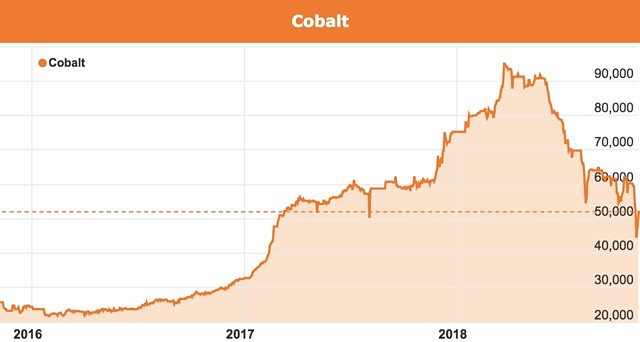Glencore ceases cobalt sales from DRC mine, triggers cobalt price surge

Cobalt prices have bounced 12.43% in the past week on news Glencore had found uranium in its cobalt at the Kamoto mine in the DRC.
News that Glencore has temporarily suspended sales from its Kamoto cobalt project in the Democratic Republic of Congo has triggered a sudden price surge for cobalt, with the mineral’s value soaring more than 12% within three days.
Earlier this week, Glencore’s 86%-owned subsidiary Katanga Mining reported sales and exports had halted at the mine as a result of the discovery of uranium.
According to Katanga, uranium levels had been found to exceed the “acceptable limit allowed” for its cobalt to be exported through Africa’s primary ports.
To-date, Katanga revealed the presence of uranium had prevented 1,472 tonnes of cobalt from being exported.
The news rocked the global cobalt market and pushed the commodity’s price from under US$45,000 per tonne to US$52,000/t within days.
Cobalt market
Cobalt is currently one of the most in-demand commodities, given an acceleration of the global electric vehicle market where the metal is a crucial component in the production of lithium-ion batteries.
The value of the bluish-grey metal has almost tripled since the EV revolution took off, fuelled primarily by US-based Tesla Motors which built its original model around a lithium-nickel-cobalt-aluminium (Li-NCA) cathode and now plans to launch the Model 3 with a new generation lithium-nickel-manganese-cobalt (Li-NMC) formulation.
And cobalt producers worldwide have leapt to the impending demand challenge, with increased production and sales tipping the market into oversupply this year.
Kamoto project
During the 1980s, Kamoto produced an average 3 million tonnes of ore per year and prior to its restart in 2007 under Katanga’s ownership, the mine had produced a total 59.3Mt, with an average cobalt grade of 0.37% and a copper grade of 4.21%.
But while Kamoto boasts one of the Congo’s biggest reserves of copper and cobalt, it has a track record as an under-performing asset, and Glencore has already been forced to suspend operations once since grabbing a stake in Katanga in 2009.
The suspension occurred in 2015 when Kamoto’s production costs soared in a low commodity price environment, and Glencore addressed the problem by upgrading and modernising the mine’s processing plant.
Second hurdle
This week, Glencore hit its second hurdle with Kamoto after ceasing sales due to the presence of uranium.
While the company said the low levels of radioactivity did not present a health or safety risk, it also confirmed the amount found exceeds trucking limits from the DRC to major ports and therefore must be removed before sales can progress.
To resolve the situation, Katanga stated it plans to build a $25 million ion exchange system to remove the uranium and will stockpile the affected material until the mid-year completion date.
Despite the cessation of sales, Katanga stated copper and cobalt mining would continue at without “reduction in the quantity produced”.
Katomo had ramped up production since re-opening in late 2017 and was expected to generate 34,000t of cobalt in 2019, signalling the largest output of any mine in the world.
But according to some reports, Glencore has a history of curbing supply to meet demand, and has been known to criticise its rivals for producing too much and depressing prices.
This latest suspension at Katomo is expected to tighten supply and help push prices higher again.
The actual benefit will depend on reactions from the wider cobalt market.
The price is right
Despite the recent price surge, the cobalt market tipped into oversupply this year after producers worldwide increased production and sales of the commodity.
According to Glencore chief executive Ivan Glasenberg, mining companies need to “get a handle on production” in order for the cobalt price to right itself.
“Mining companies have to wake up and stop increasing supply and look at demand,” he says. “And that is it.”
In July, London Metals Exchange prices for cobalt sat around US$74,500 per tonne but slipped almost 23% by the end of the quarter to US$57,500/t – a far cry from June’s peak of $82,750/t.
An essential element
Cobalt is an essential element in many of the items society takes for granted including electric vehicles, rechargeable batteries and medical applications such as radiotherapy.
In recent years, consumer electronics have represented the bulk of cobalt demand, with Apple being one of the largest end-users.
Earlier this year, the tech giant – which uses 100% cobalt oxide or lithium-cobalt oxide batteries in its smartphones, tablets, watches and laptops – was reportedly in talks to buy long-term supplies of cobalt directly from mining companies for the first time in its history, thereby securing the raw material needed to bring its innovations to life.
Previously, Apple has left cobalt negotiations to third party companies which produce the batteries for its products.
If the reports are true, Apple will find itself in competition with carmakers and battery producers to lock up cobalt supplies to meet their forward targets.
BMW is also aiming to be an early mover – in February, the German carmaker was reported to be on the verge of signing a 10-year deal for the supply of cobalt and lithium to help realise its long-term EV ambitions.
Such mass consumption within a tight commodity market is expected to reverse cobalt’s recent decline, with this week’s price hike potentially only the beginning of another upward ride.

